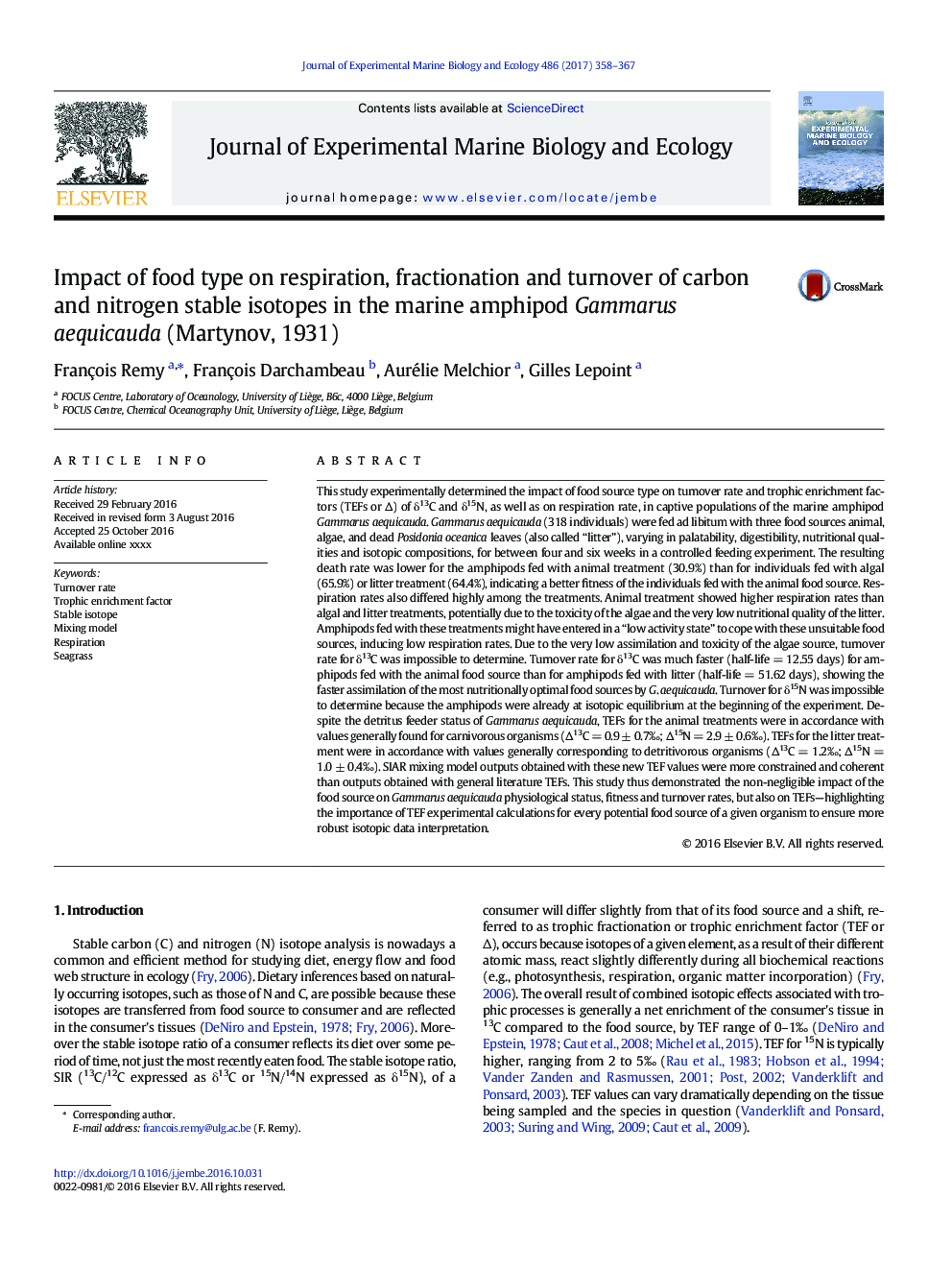| کد مقاله | کد نشریه | سال انتشار | مقاله انگلیسی | نسخه تمام متن |
|---|---|---|---|---|
| 8849056 | 1618389 | 2017 | 10 صفحه PDF | دانلود رایگان |
عنوان انگلیسی مقاله ISI
Impact of food type on respiration, fractionation and turnover of carbon and nitrogen stable isotopes in the marine amphipod Gammarus aequicauda (Martynov, 1931)
دانلود مقاله + سفارش ترجمه
دانلود مقاله ISI انگلیسی
رایگان برای ایرانیان
کلمات کلیدی
موضوعات مرتبط
علوم زیستی و بیوفناوری
علوم کشاورزی و بیولوژیک
علوم آبزیان
پیش نمایش صفحه اول مقاله

چکیده انگلیسی
This study experimentally determined the impact of food source type on turnover rate and trophic enrichment factors (TEFs or â) of δ13C and δ15N, as well as on respiration rate, in captive populations of the marine amphipod Gammarus aequicauda. Gammarus aequicauda (318 individuals) were fed ad libitum with three food sources animal, algae, and dead Posidonia oceanica leaves (also called “litter”), varying in palatability, digestibility, nutritional qualities and isotopic compositions, for between four and six weeks in a controlled feeding experiment. The resulting death rate was lower for the amphipods fed with animal treatment (30.9%) than for individuals fed with algal (65.9%) or litter treatment (64.4%), indicating a better fitness of the individuals fed with the animal food source. Respiration rates also differed highly among the treatments. Animal treatment showed higher respiration rates than algal and litter treatments, potentially due to the toxicity of the algae and the very low nutritional quality of the litter. Amphipods fed with these treatments might have entered in a “low activity state” to cope with these unsuitable food sources, inducing low respiration rates. Due to the very low assimilation and toxicity of the algae source, turnover rate for δ13C was impossible to determine. Turnover rate for δ13C was much faster (half-life = 12.55 days) for amphipods fed with the animal food source than for amphipods fed with litter (half-life = 51.62 days), showing the faster assimilation of the most nutritionally optimal food sources by G. aequicauda. Turnover for δ15N was impossible to determine because the amphipods were already at isotopic equilibrium at the beginning of the experiment. Despite the detritus feeder status of Gammarus aequicauda, TEFs for the animal treatments were in accordance with values generally found for carnivorous organisms (â13C = 0.9 ± 0.7â°; â15N = 2.9 ± 0.6â°). TEFs for the litter treatment were in accordance with values generally corresponding to detritivorous organisms (â13C = 1.2â°; â15N = 1.0 ± 0.4â°). SIAR mixing model outputs obtained with these new TEF values were more constrained and coherent than outputs obtained with general literature TEFs. This study thus demonstrated the non-negligible impact of the food source on Gammarus aequicauda physiological status, fitness and turnover rates, but also on TEFs-highlighting the importance of TEF experimental calculations for every potential food source of a given organism to ensure more robust isotopic data interpretation.
ناشر
Database: Elsevier - ScienceDirect (ساینس دایرکت)
Journal: Journal of Experimental Marine Biology and Ecology - Volume 486, January 2017, Pages 358-367
Journal: Journal of Experimental Marine Biology and Ecology - Volume 486, January 2017, Pages 358-367
نویسندگان
François Remy, François Darchambeau, Aurélie Melchior, Gilles Lepoint,